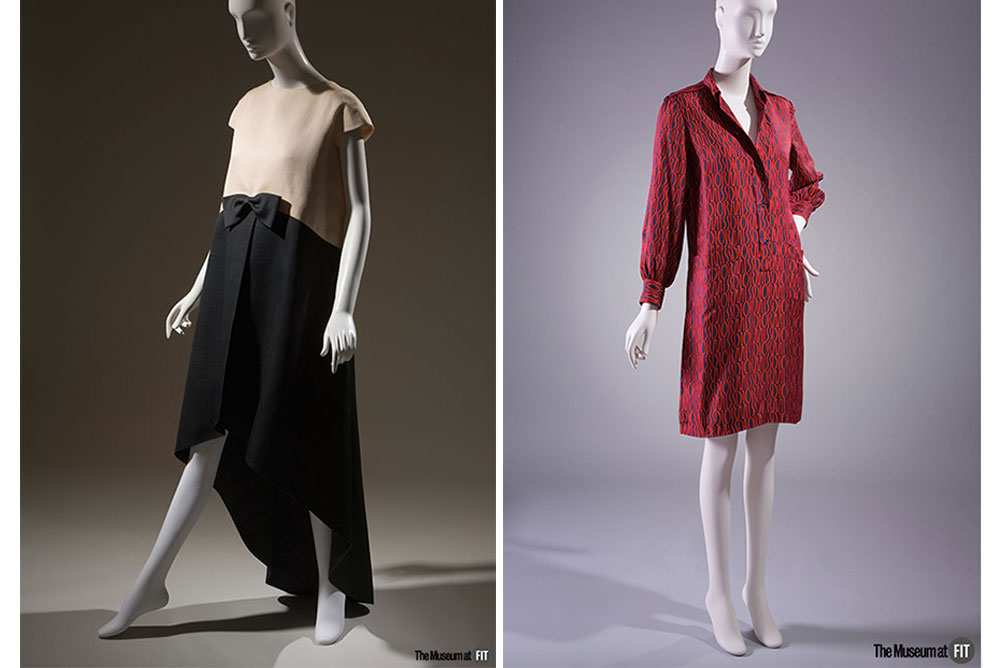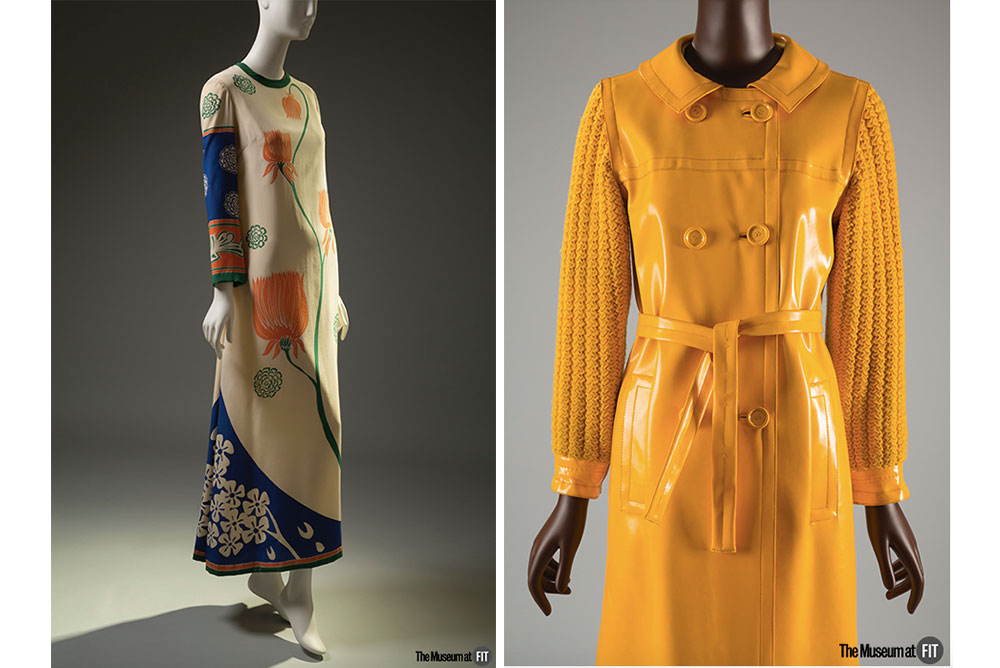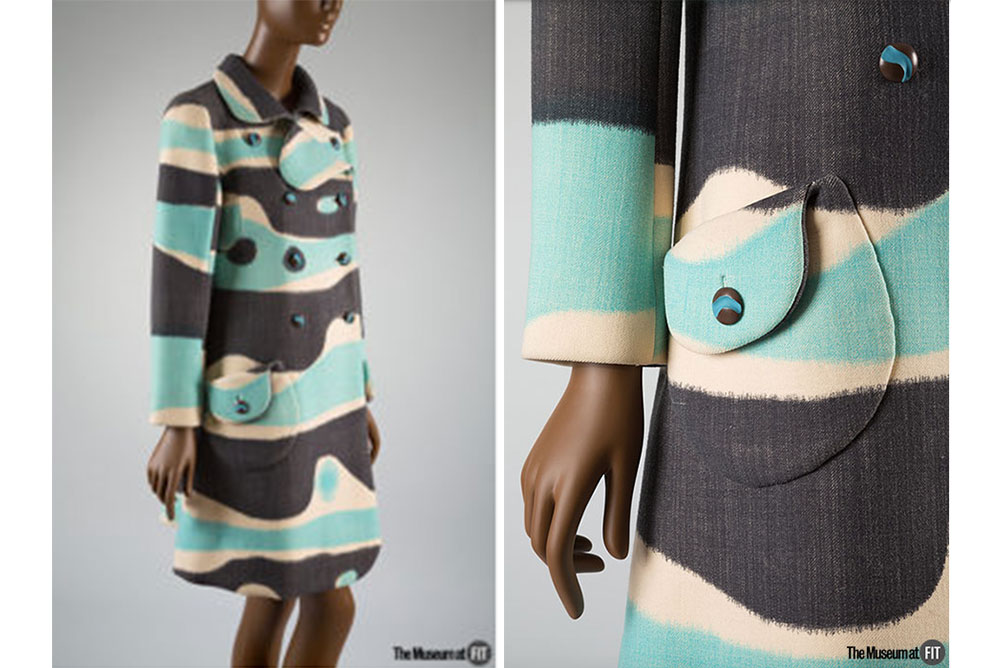FIT’S MUSEUM calls itself “the most fashionable museum in New York City.” And so it is, in the heart of the Garment District, where FIT (the Fashion Institute of Technology) trains kids to go out there and design and sew and then sew some more.
During the coronavirus, of course, everything at the school has gone online-only, including the museum. We’ve publicized a few of the museum’s exhibits (links listed at the end), and FIT has given us the gift of allowing highlights from its shows be seen on its website. The exhibit we just discovered is from a show mounted in 2017, “Paris Refashioned, 1957-1968,” curated by FIT’s Colleen Hill. So . . . beginning post-Dior New Look and ending, why, exactly, 1968?
That was the year, the exhibit materials explain, that the couturier Cristóbal Balenciaga, the reigning leader of Paris couture, closed his house, lamenting that it had become impossible to design true couture. It was also a year or two after Yves Saint Laurent had begun his Rive Gauche boutique and ready-to-wear line and the House of Dior had begun a “diffusion” line, ready-to-wear clothing for younger women, a wider market without the means for extravagant dress, extravagant in terms of both money and time (for several fittings). The geometry of the couture had already begun to loosen, influenced by the hippie aesthetic and, let’s face it, the looser way of life that hasn’t become any stricter as the years have rolled on.
The genius of the clothes shown here is that they could be worn today without turning heads except in admiration. (Of course, that presupposes that anyone had anywhere to go these days.) So in lieu of wearing them, at least we can look at them and appreciate them. Our captions are taken from the exhibit materials.
—Nancy McKeon

LEFT: Balenciaga was clearly frustrated by the 1960s, but his work from that decade is exceptional. A dress from the collection of The Museum at FIT, created just before Balenciaga’s retirement, provides an example of the canted hemline he refined over the course of the 1960s. When the wearer moved, the dress would swing to create a perfectly conical shape. When she stood still, the fabric fell into soft vertical folds. A video from the same period offers a glimpse of the designer’s stunning work in motion. / Balenciaga evening gown, 1968. Gift of Mrs. Ephraim London, Mrs. Rowland Mindlin and Mrs. Walter Eytan in Memory of Mrs. M. Lincoln Schuster.
RIGHT: The House of Dior launched a successful boutique line in 1947, and although its offerings were much more accessible than couture, they were by no means inexpensive. In order to reach a wider audience, in 1967 the company opened a new, lower-priced boutique called Miss Dior.
Philippe Guibourgé designed the Miss Dior clothing, which initially comprised 68 styles of dresses, coats and suits, in addition to a full range of separates and accessories. These designs were well priced, resolutely practical and casual: Not a single formal evening dress was to be found. The House of Dior had purchased a factory in which the garments were made, ensuring that they were of better quality than many other ready-to-wear offerings being manufactured in France.
The pride that Dior took in its new venture is best evidenced by a shirtdress dating to 1967, also featured in Elle, made from red and blue silk emblazoned with the words “Miss Dior” in an allover pattern. This early example of branding speaks to the importance of a consumer’s ability to “buy in” to a luxury brand at relatively little cost, a concept that would become more fully developed during the next decade and beyond. / Miss Dior dress (Philippe Guibourgé), 1968. Gift of Mrs. Walter Eytan.

LEFT: Gaby Aghion founded the label Chloé shortly after she arrived in Paris from her native Egypt in 1952. Aghion’s goal was to provide women with clothing that was easily accessible and modern, yet of a much higher quality than typical French ready-to-wear fashion. Aghion’s designs were sold off-the-rack at several boutiques that she herself frequented, but a seamstress trained in haute couture techniques had made them, ensuring that the garments were of high quality.
At the encouragement of Maïme Arodin, editor of the influential fashion magazine Jardin des modes, Aghion relinquished her role as the label’s sole designer and began to recruit a number of new talents to carry Chloé forward. These designers included Christiane Bailly, Maxime de la Falaise, Graziella Fontana, Tan Giudicelli, Gérard Pipart and Michèle Rosier. Of Aghion’s many successful hires, none gained more recognition than Karl Lagerfeld, who began working for the label in 1964. His sense of fantasy and exuberance, as well as his creative reinterpretations of historical styles, soon came to characterize the Chloé brand. His impact was such that he was frequently distinguished as the creator of a certain garment in a way that the other Chloé designers were not (the credit line “Karl Lagerfeld for Chloé” appeared in VogueParis as early as 1965). / Chloé by Karl Lagerfeld, “Astoria” dress, 1967. Gift of Melanie Miller.
This raincoat is one of the earliest Rive Gauche designs (Catherine Deneuve wore a black version of it in the 1967 film Belle de Jour, for which Saint Laurent designed the costumes). It highlights the playful, vibrant aesthetic that characterized many 1960s creations for the label. Made from bright yellow vinyl with crocheted wool sleeves, it cost $90 in 1966 (the equivalent of $675 in 2017). Saint Laurent intended his Rive Gauche designs to be more fun than luxurious—but, as the journalist Marilyn Bender wryly observed in her 1967 book The Beautiful People, “Like the goose that lays golden eggs, Saint Laurent has pretty expensive notions of fun.” Nevertheless, Rive Gauche was a great success. Saint Laurent’s designs for the label were widely covered by both the French and American fashion press, and he opened a New York boutique in 1968. / Saint Laurent Rive Gauche raincoat, Fall 1966. Gift of Ethel Scull.

Emanuel Ungaro worked for Cristóbal Balenciaga and André Courrèges before starting his own label in 1965. Women’s Wear Daily was first to report on the new couture house, later providing the designer’s contact information to French and British journalists. The newspaper emphatically stated that although Ungaro was designing couture, he was certain to “defy labels,” and speculated that he would be “the force to cement the weaker forces tearing Paris apart.”
Some of Ungaro’s most compelling creations were made in collaboration with textile designer Sonia Knapp. Although Knapp was an established textile designer, she had never made couture fabrics prior to working with Ungaro. She quickly rose to the challenge, and her colorful, fluid designs—which often conveyed her interest in Abstract Expressionism—were said to “wake Ungaro up.”
The soft lines of the fabric Knapp designed for this coat echo its curved lapels and rounded patch pockets, while simultaneously contrasting the coat’s hard-edged, A-line silhouette. The garment’s immaculate construction—best exemplified by the perfectly aligned fabric—demonstrates that there remained a place for couture craftsmanship within 1960s fashion. Yet Ungaro also understood the increasing importance of ready-to-wear: In 1967, he launched a readymade line called “Emanuel Ungaro Parallèle.” The label’s offerings allowed Ungaro to design in a relaxed and lighthearted matter. / Emanuel Ungaro coat (Fabric by Sonia Knapp), 1968. Gift of Rodman A. Heeren.
Some other FIT exhibits:
Norell: Elegant The, Elegant Now
Clothes Encounters of the Historical Kind

Thanks for this post. I look forward to hours of pleasure as I tour the site.
How I miss going to museums! And how I miss getting dressed in anything other than leggings, jeans and sweatpants. This was a treat.